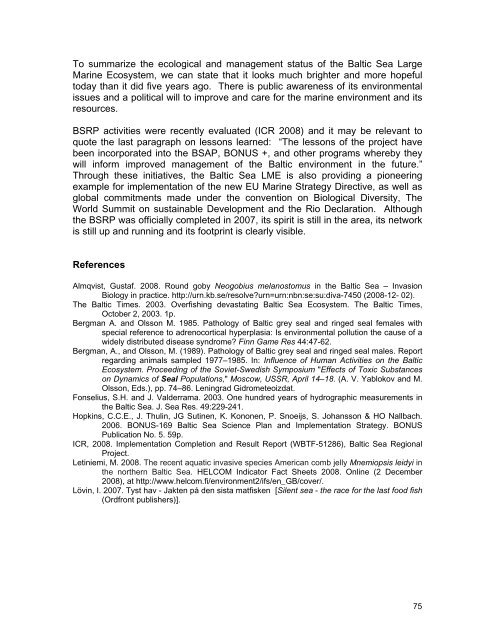Sustaining the World's Large Marine Ecosystems
Sustaining the World's Large Marine Ecosystems
Sustaining the World's Large Marine Ecosystems
You also want an ePaper? Increase the reach of your titles
YUMPU automatically turns print PDFs into web optimized ePapers that Google loves.
To summarize <strong>the</strong> ecological and management status of <strong>the</strong> Baltic Sea <strong>Large</strong><br />
<strong>Marine</strong> Ecosystem, we can state that it looks much brighter and more hopeful<br />
today than it did five years ago. There is public awareness of its environmental<br />
issues and a political will to improve and care for <strong>the</strong> marine environment and its<br />
resources.<br />
BSRP activities were recently evaluated (ICR 2008) and it may be relevant to<br />
quote <strong>the</strong> last paragraph on lessons learned: “The lessons of <strong>the</strong> project have<br />
been incorporated into <strong>the</strong> BSAP, BONUS +, and o<strong>the</strong>r programs whereby <strong>the</strong>y<br />
will inform improved management of <strong>the</strong> Baltic environment in <strong>the</strong> future.”<br />
Through <strong>the</strong>se initiatives, <strong>the</strong> Baltic Sea LME is also providing a pioneering<br />
example for implementation of <strong>the</strong> new EU <strong>Marine</strong> Strategy Directive, as well as<br />
global commitments made under <strong>the</strong> convention on Biological Diversity, The<br />
World Summit on sustainable Development and <strong>the</strong> Rio Declaration. Although<br />
<strong>the</strong> BSRP was officially completed in 2007, its spirit is still in <strong>the</strong> area, its network<br />
is still up and running and its footprint is clearly visible.<br />
References<br />
Almqvist, Gustaf. 2008. Round goby Neogobius melanostomus in <strong>the</strong> Baltic Sea – Invasion<br />
Biology in practice. http://urn.kb.se/resolve?urn=urn:nbn:se:su:diva-7450 (2008-12- 02).<br />
The Baltic Times. 2003. Overfishing devastating Baltic Sea Ecosystem. The Baltic Times,<br />
October 2, 2003. 1p.<br />
Bergman A. and Olsson M. 1985. Pathology of Baltic grey seal and ringed seal females with<br />
special reference to adrenocortical hyperplasia: Is environmental pollution <strong>the</strong> cause of a<br />
widely distributed disease syndrome? Finn Game Res 44:47-62.<br />
Bergman, A., and Olsson, M. (1989). Pathology of Baltic grey seal and ringed seal males. Report<br />
regarding animals sampled 1977–1985. In: Influence of Human Activities on <strong>the</strong> Baltic<br />
Ecosystem. Proceeding of <strong>the</strong> Soviet-Swedish Symposium "Effects of Toxic Substances<br />
on Dynamics of Seal Populations," Moscow, USSR, April 14–18. (A. V. Yablokov and M.<br />
Olsson, Eds.), pp. 74–86. Leningrad Gidrometeoizdat.<br />
Fonselius, S.H. and J. Valderrama. 2003. One hundred years of hydrographic measurements in<br />
<strong>the</strong> Baltic Sea. J. Sea Res. 49:229-241.<br />
Hopkins, C.C.E., J. Thulin, JG Sutinen, K. Kononen, P. Snoeijs, S. Johansson & HO Nallbach.<br />
2006. BONUS-169 Baltic Sea Science Plan and Implementation Strategy. BONUS<br />
Publication No. 5. 59p.<br />
ICR, 2008. Implementation Completion and Result Report (WBTF-51286), Baltic Sea Regional<br />
Project.<br />
Letiniemi, M. 2008. The recent aquatic invasive species American comb jelly Mnemiopsis leidyi in<br />
<strong>the</strong> nor<strong>the</strong>rn Baltic Sea. HELCOM Indicator Fact Sheets 2008. Online (2 December<br />
2008), at http://www.helcom.fi/environment2/ifs/en_GB/cover/.<br />
Lövin, I. 2007. Tyst hav - Jakten på den sista matfisken [Silent sea - <strong>the</strong> race for <strong>the</strong> last food fish<br />
(Ordfront publishers)].<br />
75









